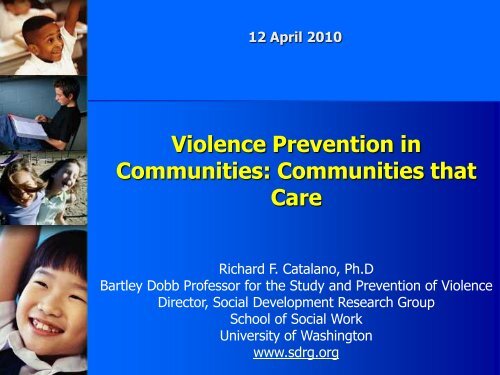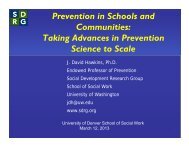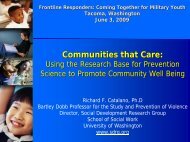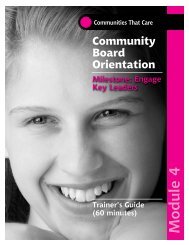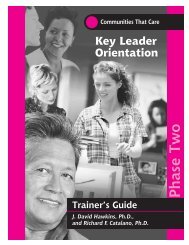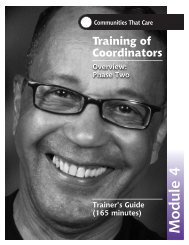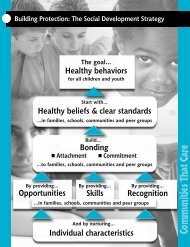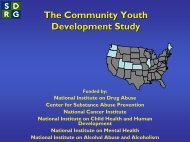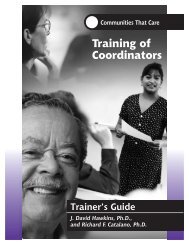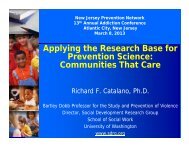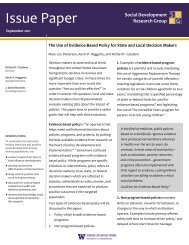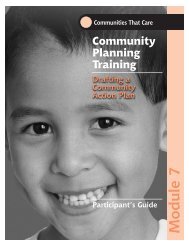Violence Prevention in Communities: Communities that Care
Violence Prevention in Communities: Communities that Care
Violence Prevention in Communities: Communities that Care
You also want an ePaper? Increase the reach of your titles
YUMPU automatically turns print PDFs into web optimized ePapers that Google loves.
12 April 2010<br />
<strong>Violence</strong> <strong>Prevention</strong> <strong>in</strong><br />
<strong>Communities</strong>: <strong>Communities</strong> <strong>that</strong><br />
<strong>Care</strong><br />
Richard F. Catalano, Ph.D<br />
Bartley Dobb Professor for the Study and <strong>Prevention</strong> of <strong>Violence</strong><br />
Director, Social Development Research Group<br />
School of Social Work<br />
University of Wash<strong>in</strong>gton<br />
www.sdrg.org
Intervention Spectrum<br />
Treatment<br />
Source: Institute of Medic<strong>in</strong>e (2009). Prevent<strong>in</strong>g Mental, Emotional and<br />
Behavioral Disorders Among Young People. O’Connell, Boat & Warner<br />
(eds.) Wash<strong>in</strong>gton DC: National Academy Press
<strong>Prevention</strong> Science<br />
Framework<br />
Program<br />
Implementation<br />
and<br />
Evaluation<br />
Def<strong>in</strong>e the<br />
Problem<br />
Identify Risk<br />
and Protective<br />
Factors<br />
Interventions<br />
Problem<br />
Response
<strong>Prevention</strong> Science<br />
Research Advances<br />
Etiology/Epidemiology of Problem Behaviors<br />
• Identify risk and protective factors <strong>that</strong><br />
predict problem behaviors and describe<br />
their distribution <strong>in</strong> populations.<br />
Efficacy Trials<br />
• Design and test preventive <strong>in</strong>terventions<br />
to <strong>in</strong>terrupt causal processes <strong>that</strong> lead to<br />
youth problems.
Risk Factors for<br />
Adolescent Problem Behaviors<br />
Risk Factors<br />
Substance Abuse<br />
Del<strong>in</strong>quency<br />
Teen Pregnancy<br />
School Drop-Out<br />
<strong>Violence</strong><br />
Depression &<br />
Anxiety<br />
Community<br />
Availability of Drugs<br />
<br />
<br />
Availability of Firearms<br />
<br />
<br />
Community Laws and Norms Favorable<br />
Toward Drug Use, Firearms, and Crime<br />
<br />
<br />
<br />
Media Portrayals of <strong>Violence</strong><br />
<br />
Transitions and Mobility<br />
<br />
<br />
<br />
<br />
Low Neighborhood Attachment and<br />
Community Disorganization<br />
<br />
<br />
<br />
Extreme Economic Deprivation
Family<br />
School<br />
Individual/Peer
Protective Factors<br />
Individual Characteristics<br />
– High Intelligence<br />
– Resilient Temperament<br />
– Competencies and Skills<br />
In each social doma<strong>in</strong> (family, school, peer<br />
group and neighborhood)<br />
– Positive Opportunities<br />
– Re<strong>in</strong>forcement for Positive Involvement<br />
– Bond<strong>in</strong>g<br />
– Healthy Beliefs and Clear Standards
Prevalence<br />
Prevalence of 30 Day Alcohol Use<br />
by Number of Risk and Protective Factors<br />
Six State Student Survey of 6th-12th Graders, Public School<br />
Students<br />
100%<br />
90%<br />
80%<br />
70%<br />
60%<br />
50%<br />
40%<br />
30%<br />
20%<br />
10%<br />
Number of<br />
Protective Factors<br />
0 to 1<br />
2 to 3<br />
4 to 5<br />
6 to 7<br />
8 to 9<br />
0%<br />
0 to 1 2 to 3 4 to 5 6 to 7 8 to 9 10+<br />
Number of Risk Factors
Prevalence<br />
Prevalence of “Attacked to Hurt”<br />
By Number of Risk and Protective Factors<br />
60%<br />
50%<br />
40%<br />
30%<br />
20%<br />
Protection, Level 0<br />
Protection, Level 1<br />
Protection, Level 2<br />
Protection, Level 3<br />
Protection, Level 4<br />
10%<br />
0%<br />
Risk, Level<br />
0<br />
Risk, Level<br />
1<br />
Risk, Level<br />
2<br />
Risk, Level<br />
3<br />
Risk, Level<br />
4
Prevalence of Other Problems<br />
by Number of Risk Factors<br />
50<br />
40<br />
%<br />
30<br />
20<br />
10<br />
depressive<br />
symptomatology<br />
deliberate self harm<br />
homelessness<br />
early sexual activity<br />
0<br />
0-1 2-3 4-6 7-9 >=10<br />
Risk factors<br />
Bond, Thomas, Toumbourou,<br />
Patton, and Catalano, 2000
Number of School Build<strong>in</strong>g Level Risk<br />
Factors and Probability of Meet<strong>in</strong>g<br />
Achievement Test Standard<br />
(10 th Grade Students)<br />
Probability of Meet<strong>in</strong>g Standard<br />
1.0<br />
0.9<br />
0.8<br />
0.7<br />
0.6<br />
0.5<br />
0.4<br />
0.3<br />
0.2<br />
0.1<br />
0.0<br />
0 1 2 3 4 5 6 7 8 9 10 11 12 13 14 15 16<br />
Number of Risk Factors<br />
Arthur et al., 2006<br />
Math Read<strong>in</strong>g Writ<strong>in</strong>g
Snowball: Snowstorm: Risk Extended Accumulates<br />
Exposure to<br />
Antisocial Norms and Models of<br />
Problem Behavior without Protection<br />
Factors Shap<strong>in</strong>g Child and<br />
through Early Developmental<br />
Adolescent Development<br />
Challenges without Protection<br />
Community<br />
Peers<br />
School<br />
Parents<br />
Toumbourou and Catalano, 2005<br />
1 2 3 4 5 6 7 8 9 10 11 12 13 14 15 16 17 18 19
<strong>Violence</strong> Specific Research Questions<br />
1. To what extent is there cont<strong>in</strong>uity between primary<br />
school aggression and age 19 violence?<br />
2. Do Year 7,8 family, peer, and school <strong>in</strong>fluences predict<br />
age 19 violence?<br />
13
Answers to <strong>Violence</strong> Specific Question 1<br />
Aggression <strong>in</strong> primary strongly predicts Age 19<br />
violence, however;<br />
There is a lot of discont<strong>in</strong>uity, and<br />
Many youth take up violence <strong>in</strong> adolescence<br />
without a history of aggression<br />
14
Transitional Probabilities<br />
Transitional Probabilities from Childhood Aggression to<br />
Youth <strong>Violence</strong> age 19<br />
15
What Year 7/8 Factors Predict Age 19 <strong>Violence</strong>?<br />
Drug use<br />
risk<br />
<strong>in</strong>dex<br />
Low vs.<br />
high<br />
violence<br />
Parental monitor<strong>in</strong>g<br />
-.41*<br />
Family rules<br />
-.36*<br />
Appropriate consequences for youth behavior<br />
-.40*<br />
-.17*<br />
-.14*<br />
-.14*<br />
Bond<strong>in</strong>g to parents<br />
-.22*<br />
-.10*<br />
Interaction with prosocial peers<br />
Peers’ recognition for prosocial <strong>in</strong>volvement<br />
-.34*<br />
-.25*<br />
-.18*<br />
-.12*<br />
Prosocial structured after school activities<br />
Academic achievement<br />
Attachment to school<br />
Commitment to school<br />
Teachers’ recognition for school work<br />
-.13*<br />
-.33*<br />
-.25*<br />
-.32*<br />
-.35*<br />
-.09*<br />
-.16*<br />
-.08*<br />
-.15*<br />
-.14*<br />
Control: Drug Use Risk Index<br />
-<br />
.22*<br />
16
Parental Monitor<strong>in</strong>g Provides Additional<br />
Protection for Early Aggressive Youth<br />
17
Answer to <strong>Violence</strong> Specific Question 2<br />
‣Do <strong>in</strong>fluences <strong>in</strong> early secondary school predict<br />
age 19 youth violence?<br />
Bond<strong>in</strong>g to prosocial parents, prosocial peer<br />
association, structured after school activities,<br />
academic achievement, and school commitment<br />
directly reduce risk of youth violence<br />
Among highly aggressive children, parental<br />
monitor<strong>in</strong>g reduces violence to the level of those<br />
without high levels of childhood aggression.<br />
18
<strong>Prevention</strong> Implications<br />
‣ Childhood aggression rema<strong>in</strong>ed a significant predictor of youth<br />
violence <strong>in</strong> presence of promotive and protective factors .<br />
Therefore, a two pronged approach may be most effective:<br />
Early universal <strong>in</strong>tervention to prevent childhood aggression<br />
Targeted or <strong>in</strong>dicated prevention for those who are aggressive;<br />
enhanc<strong>in</strong>g parental monitor<strong>in</strong>g may be particularly important.<br />
‣ The large number of early secondary school violence onsetters<br />
suggests <strong>that</strong> universal strategies designed to <strong>in</strong>tervene <strong>in</strong><br />
early adolescence are also needed.<br />
‣ Enhanc<strong>in</strong>g prosocial <strong>in</strong>fluences with<strong>in</strong> family, peer, and school is<br />
important for universal and selected violence prevention.<br />
‣ Given the important <strong>in</strong>fluence of drug use on youth violence,<br />
violence prevention programs need to target drug use<br />
19
But…<br />
• Different neighborhoods have<br />
different profiles of risk,<br />
protection, and outcomes.
Distribution of Risk <strong>in</strong> a City<br />
Neighborhood #2<br />
Insufficient number of<br />
students <strong>in</strong> this area.<br />
No students<br />
<strong>in</strong> this area.<br />
Neighborhood #1 Neighborhood #3<br />
John A. Pollard, Ph.D. Developmental Research and Programs
<strong>Prevention</strong> Science<br />
Research Advances<br />
Etiology/Epidemiology of Problem Behaviors<br />
• Identify risk and protective factors <strong>that</strong><br />
predict problem behaviors and describe<br />
their distribution <strong>in</strong> populations.<br />
Efficacy Trials<br />
• Design and test preventive <strong>in</strong>terventions<br />
to <strong>in</strong>terrupt causal processes <strong>that</strong> lead<br />
to youth problems.
Ineffective <strong>Prevention</strong><br />
Strategies<br />
Universal <strong>Prevention</strong><br />
• Peer counsel<strong>in</strong>g,<br />
mediation, positive peer<br />
culture<br />
• Non-promotion to<br />
succeed<strong>in</strong>g grades<br />
• After school activities with<br />
limited supervision,<br />
programm<strong>in</strong>g<br />
Selected, Indicated<br />
<strong>Prevention</strong><br />
• Gun buyback programs<br />
• Firearm tra<strong>in</strong><strong>in</strong>g<br />
• Mandatory gun ownership<br />
• Redirect<strong>in</strong>g youth behavior<br />
• Shift<strong>in</strong>g peer group norms<br />
• Neighborhood Watch<br />
• Drug <strong>in</strong>formation, fear<br />
arousal, moral appeal.<br />
• DARE (new and old)<br />
U.S. Surgeon General, U.S. Department of Health and Human Services,<br />
2001; National Institute of Justice, 1998; Gottfredson, 1997.
Wide Rang<strong>in</strong>g Approaches<br />
Have Been Found To Be<br />
Effective<br />
1. Prenatal & Infancy Programs<br />
2. Early Childhood Education<br />
3. Parent Tra<strong>in</strong><strong>in</strong>g<br />
4. After-school Recreation<br />
5. Mentor<strong>in</strong>g with Cont<strong>in</strong>gent<br />
Re<strong>in</strong>forcement<br />
6. Youth Employment with<br />
Education<br />
7. Organizational Change <strong>in</strong><br />
Schools<br />
(Hawk<strong>in</strong>s & Catalano, 2004)<br />
8. Classroom<br />
Organization,<br />
Management, and<br />
Instructional Strategies<br />
9. School Behavior<br />
Management Strategies<br />
10. Classroom Curricula for<br />
Social Competence<br />
Promotion<br />
11. Community & School<br />
Policies<br />
12. Community<br />
Mobilization
Summary of Benefits and Costs (2003 Dollars)<br />
Dollars Per Youth (PV<br />
lifecycle)<br />
Selected Benefit Cost F<strong>in</strong>d<strong>in</strong>gs<br />
Benefits Costs B - C<br />
Early Childhood Education $17,202 $7,301 $9,901<br />
Nurse Family Partnership $26,298 $9,118 $17,180<br />
Life Skills Tra<strong>in</strong><strong>in</strong>g $746 $29 $717<br />
Seattle Soc. Dev. Project $14,246 $4,590 $9,837<br />
Guid<strong>in</strong>g Good Choices $7,605 $687 $6,918<br />
Multi-D Treat. Foster <strong>Care</strong> $26,748 $2,459 $24,290<br />
Intensive Juv. Supervision $0 $1,482 -$1,482<br />
Big Brothers/Sisters (all costs) $4,058 $4,010 $48<br />
(taxpayer costs only) $4,058 $1,283 $2,775<br />
Steve Aos, Associate Director<br />
Wash<strong>in</strong>gton State Institute for Public Policy<br />
saos@wsipp.wa.gov www.wa.gov/wsipp
However…<br />
• <strong>Prevention</strong> approaches <strong>that</strong> do not<br />
work or have not been evaluated<br />
have been more widely used than<br />
those shown to be effective.<br />
(Gottfredson et al 2000, Hallfors et al 2000, Hantman<br />
et al 2000, Mendel et al 2000, Silvia et al 1997; Smith<br />
et al 2002)
Challenges for States and<br />
<strong>Communities</strong> <strong>in</strong> Us<strong>in</strong>g<br />
<strong>Prevention</strong> Science<br />
• Match<strong>in</strong>g tested, effective programs to local<br />
need<br />
• Tested, effective programs/systems compete<br />
with “best,” usual, or new practice<br />
• Tested, effective programs require tra<strong>in</strong><strong>in</strong>g,<br />
technical assistance, and monitor<strong>in</strong>g to be<br />
delivered with fidelity<br />
• Achiev<strong>in</strong>g population wide outcomes<br />
• Need for coord<strong>in</strong>ated plann<strong>in</strong>g and fund<strong>in</strong>g,<br />
and accountability for youth outcomes
<strong>Communities</strong> <strong>that</strong> <strong>Care</strong> Model<br />
for Achiev<strong>in</strong>g the Vision of<br />
Science Inform<strong>in</strong>g Practice<br />
Provides the education, skills and<br />
tools to build community<br />
capacity to be accountable to<br />
change youth outcomes<br />
through choos<strong>in</strong>g and<br />
implement<strong>in</strong>g tested, effective<br />
programs matched to their<br />
needs
The <strong>Communities</strong> That <strong>Care</strong><br />
Operat<strong>in</strong>g System<br />
Get Started<br />
• Community read<strong>in</strong>ess<br />
assessment.<br />
• Identification of key<br />
<strong>in</strong>dividuals, stakeholders,<br />
and organizations.<br />
Implement and<br />
Evaluate<br />
Creat<strong>in</strong>g<br />
<strong>Communities</strong><br />
That <strong>Care</strong><br />
Get Organized<br />
Create a Plan<br />
Develop a Profile
The <strong>Communities</strong> That <strong>Care</strong><br />
Operat<strong>in</strong>g System<br />
Implement and<br />
Evaluate<br />
Get Started<br />
Creat<strong>in</strong>g<br />
<strong>Communities</strong><br />
That <strong>Care</strong><br />
• Tra<strong>in</strong><strong>in</strong>g key leaders<br />
and board <strong>in</strong> CTC<br />
• Build<strong>in</strong>g the<br />
community coalition.<br />
Get Organized<br />
Create a Plan<br />
Develop a Profile
The <strong>Communities</strong> That <strong>Care</strong><br />
Tools for Decision Mak<strong>in</strong>g<br />
Get Started<br />
Implement and<br />
Evaluate<br />
Creat<strong>in</strong>g<br />
<strong>Communities</strong><br />
That <strong>Care</strong><br />
• Collect<br />
risk/protective factor<br />
Get Organized<br />
and outcome data.<br />
• Construct a<br />
community profile<br />
from the data.<br />
Create a Plan<br />
Develop a Profile
Better Youth Services Pilot<br />
Learn<strong>in</strong>gs<br />
Guid<strong>in</strong>g pr<strong>in</strong>ciples for the provision of data <strong>that</strong><br />
could <strong>in</strong>form local plann<strong>in</strong>g<br />
•Specific to young people of each area<br />
•Able to measure locally prioritised issues<br />
•Presented <strong>in</strong> a standardised, easy to analyse format<br />
•Provided consistently over a period of time to enable<br />
monitor<strong>in</strong>g and evaluation of local <strong>in</strong>itiatives<br />
•Format <strong>that</strong> allows patterns across the age span 10-<br />
25 years<br />
•Easy to replicate and produce on a regular basis<br />
•Replicated on a state, regional and/or local level <strong>in</strong><br />
order to allow data analysis through benchmark<strong>in</strong>g
The CTC Youth Survey Tool<br />
Helps Match Need to Tested,<br />
Effective Programs<br />
• Identifies levels of 21 risk and 9<br />
protective factors and academic and<br />
behavioral outcomes<br />
• Guides planners to select tested, effective<br />
actions<br />
• Monitors the effects of chosen actions<br />
• Basis of the Victorian Adolescent Health<br />
and Wellbe<strong>in</strong>g Survey
The <strong>Communities</strong> That <strong>Care</strong><br />
Tools for Decision Mak<strong>in</strong>g<br />
Get Started<br />
Implement and<br />
• Def<strong>in</strong>e outcomes.<br />
•Prioritize risk factors to be<br />
Evaluate<br />
targeted.<br />
• Select tested, effective<br />
<strong>in</strong>terventions.<br />
• Create action plan.<br />
• Develop evaluation plan.<br />
Creat<strong>in</strong>g<br />
<strong>Communities</strong><br />
That <strong>Care</strong><br />
Get Organized<br />
Create a Plan<br />
Develop a Profile
Percentage of Youth at Risk<br />
Low Neighborhood Attachment<br />
Community Disorganization<br />
Laws & Norms Favor Drug Use<br />
Perceived Availability of Drugs<br />
Perceived Availability of Handguns<br />
Poor Family Management<br />
Family Conflict<br />
amily History of Antisocial Behavior<br />
Parent Attitudes Favorable to ASB<br />
Parent Attitudes Favor Drug Use<br />
Academic Failure<br />
Low Commitment to School<br />
Rebelliousness<br />
Early Initiation of ASB<br />
Early Initiation of Drug Use<br />
Attitude Favorable to ASB<br />
Attitude Favorable to Drug Use<br />
Perceived Risk of Drug Use<br />
Interaction with Antisocial Peers<br />
Friends' Use of Drugs<br />
Rewards for ASB<br />
Depressive Symptoms<br />
Intention to Use Drugs<br />
Schenectady High School<br />
Gang Involvement<br />
Total Risk<br />
School A<br />
2005 Risk Profile<br />
100%<br />
Community Family School Peer-Individual Total<br />
90%<br />
80%<br />
70%<br />
60%<br />
50%<br />
40%<br />
30%<br />
20%<br />
10%<br />
0%
Individual/Peer Doma<strong>in</strong><br />
Protective Factors<br />
Risk Factor Addressed<br />
Rebelliousness<br />
Program Strategy<br />
Healthy<br />
Beliefs<br />
& Clear<br />
Standards<br />
Bond<strong>in</strong>g Opport. Skills Recog.<br />
Developmental<br />
Period<br />
Family Therapy 6-14<br />
Classroom Curricula for Social Competence<br />
Promotion<br />
6-14<br />
School Behavior Management Strategies 6-14<br />
Afterschool Recreation 6-10<br />
Mentor<strong>in</strong>g with Cont<strong>in</strong>gent Re<strong>in</strong>forcement 11-18<br />
Youth Employment with Education 15-18<br />
Friends Who Engage <strong>in</strong> the<br />
Problem Behavior<br />
Favorable Attitudes<br />
Toward the Problem<br />
Behavior<br />
Early Initiation of the<br />
Problem Behavior<br />
Parent Tra<strong>in</strong><strong>in</strong>g 6-14<br />
Classroom Curricula for Social Competence<br />
Promotion<br />
6-14<br />
Afterschool Recreation 6-14<br />
Mentor<strong>in</strong>g with Cont<strong>in</strong>gent Re<strong>in</strong>forcement 11-18<br />
Classroom Curricula for Social Competence<br />
Promotion<br />
Community/School Policies<br />
6-14<br />
Parent Tra<strong>in</strong><strong>in</strong>g 6-14<br />
Classroom Organization Management and<br />
Instructional Strategy<br />
6-10<br />
Classroom Curricula for Social Competence 6-14<br />
Community/School Policies all<br />
Constitutional Factors Prenatal/Infancy Programs prenatal-2<br />
© 1998 Developmental Research and Programs
Classroom Curricula for Social and<br />
Emotional Competence Promotion -<br />
Elementary School<br />
• (PATHS ® ) Promot<strong>in</strong>g Alternative Th<strong>in</strong>k<strong>in</strong>g<br />
Strategies (Greenberg et al., 1995)<br />
• Metropolitan Area Child Study (Huesmann et<br />
al., 1996)<br />
• Second Step: A <strong>Violence</strong> <strong>Prevention</strong><br />
Curriculum (Grossman et al. 1997)<br />
• The Children of Divorce Intervention<br />
Program (Pedro-Carroll et al., 1992)<br />
38
Classroom Curricula for Social/<br />
Emotional Competence Promotion-<br />
Secondary School<br />
• The Life Skills Tra<strong>in</strong><strong>in</strong>g Program (Botv<strong>in</strong> et<br />
al., 1995)<br />
• Project Alert Drug <strong>Prevention</strong> Curriculum<br />
(Ellickson et al., 1993; Ellickson and Bell,<br />
1990)<br />
• Alcohol Misuse <strong>Prevention</strong><br />
(Maggs et al., 1998)<br />
• Towards No Drug Use<br />
(Sussman et al. 2003; 2003)
Percentage of Youth at Risk<br />
Low Neighborhood Attachment<br />
Community Disorganization<br />
Laws & Norms Favor Drug Use<br />
Perceived Availability of Drugs<br />
Perceived Availability of Handguns<br />
Poor Family Management<br />
Family Conflict<br />
Family History of Antisocial Behavior<br />
Parent Attitudes Favorable to ASB<br />
Parent Attitudes Favor Drug Use<br />
Academic Failure<br />
Low Commitment to School<br />
Rebelliousness<br />
Early Initiation of ASB<br />
Early Initiation of Drug Use<br />
Attitude Favorable to ASB<br />
Attitude Favorable to Drug Use<br />
Perceived Risk of Drug Use<br />
Interaction with Antisocial Peers<br />
Friends' Use of Drugs<br />
Rewards for ASB<br />
Depressive Symptoms<br />
Intention to Use Drugs<br />
Gang Involvement<br />
Total Risk<br />
School A<br />
2005 Risk Profile<br />
100%<br />
Community Family School Peer-Individual Total<br />
90%<br />
80%<br />
70%<br />
60%<br />
50%<br />
40%<br />
30%<br />
20%<br />
10%<br />
0%<br />
Schenectady High School
School Doma<strong>in</strong><br />
Protective Factors<br />
Risk Factor Addressed<br />
Program Strategy<br />
Healthy<br />
Beliefs<br />
& Clear<br />
Standards<br />
Bond<strong>in</strong>g Opport. Skills Recog.<br />
Developmental<br />
Period<br />
Academic Failure<br />
(cont<strong>in</strong>ued)<br />
Classroom Organization, Management and<br />
Instructional Strategies<br />
<br />
6-18<br />
Classroom Curricula for Social<br />
Competence Promotion<br />
<br />
6-14<br />
School Behavior Management Strategies 6-14<br />
Youth Employment with Education 15-21<br />
Lack of Commitment<br />
to School<br />
Early Childhood Education 3-5<br />
Organizational Changes <strong>in</strong> Schools 6-18<br />
Classroom Organization, Management and<br />
Instructional Strategies<br />
<br />
6-18<br />
School Behavior Management Strategies 6-14<br />
Mentor<strong>in</strong>g with Cont<strong>in</strong>gent Re<strong>in</strong>forcement 11-18<br />
Youth Employment with Education 15-21
Classroom Organization,<br />
Management, and Instructional<br />
Tested, Effective Strategies<br />
• The Good Behavior Game (Kellam and Rebok,<br />
1992)<br />
• Seattle Social Development Project (Hawk<strong>in</strong>s et al.,<br />
1999; 2005; 2008)<br />
• Behavioral Intervention for Middle School Students<br />
(Bry, 1982)<br />
• Cooperative Learn<strong>in</strong>g Programs (Slav<strong>in</strong>, 1983)<br />
• Tutor<strong>in</strong>g Programs (Coie et al., 1984; Greenwood<br />
et al., 1993)<br />
• Success for All (Slav<strong>in</strong> et al., 1990)
• Form task forces.<br />
• Identify and tra<strong>in</strong> implementers.<br />
• Susta<strong>in</strong> collaborative relationships.<br />
• Evaluate processes and outcomes<br />
for programs annually.<br />
•Evaluate community outcomes<br />
every two years.<br />
• Adjust programm<strong>in</strong>g.<br />
The <strong>Communities</strong> That <strong>Care</strong><br />
Tools for Accountability<br />
Get Started<br />
Implement and<br />
Evaluate<br />
Creat<strong>in</strong>g<br />
<strong>Communities</strong><br />
That <strong>Care</strong><br />
Get Organized<br />
Create a Plan<br />
Develop a Profile
Community Youth Development Study<br />
A 24 Community Randomized Trial of CTC<br />
PI: J. David Hawk<strong>in</strong>s<br />
Co-PI: Richard F. Catalano<br />
Funded <strong>in</strong> 2003 by:<br />
National Institute on Drug Abuse<br />
Center for Substance Abuse <strong>Prevention</strong><br />
National Cancer Institute<br />
National Institute on Child Health and Development<br />
National Institute on Mental Health
<strong>Communities</strong> That <strong>Care</strong><br />
Theory of Change<br />
CTC Tra<strong>in</strong><strong>in</strong>g and<br />
Technical Assistance<br />
(Brown<br />
et al,<br />
2007)<br />
Adoption of Science-based<br />
<strong>Prevention</strong> Framework<br />
Collaboration<br />
Regard<strong>in</strong>g <strong>Prevention</strong> Issues<br />
(Qu<strong>in</strong>by<br />
et al,<br />
2008;<br />
Fagan et<br />
al.,<br />
2008,<br />
Hawk<strong>in</strong>s<br />
et al.,<br />
2008)<br />
Appropriate Choice<br />
and Implementation<br />
of Tested, Effective<br />
<strong>Prevention</strong> Programs &<br />
Adoption of Social Development<br />
Strategy as Community’s Way of<br />
Br<strong>in</strong>g<strong>in</strong>g Up Children<br />
Decreased Risk and<br />
Enhanced Protection 2<br />
years post <strong>in</strong>itiation<br />
Positive Youth<br />
Outcomes 3+<br />
years post<br />
<strong>in</strong>itiation
Effects of CTC on Onset of<br />
Drug Use and Del<strong>in</strong>quency<br />
• Onset of substance use and del<strong>in</strong>quency between<br />
grade 6 and 8:<br />
‣ Alcohol use*<br />
‣ Cigarette smok<strong>in</strong>g*<br />
‣ Smokeless tobacco use*<br />
‣ Marijuana use<br />
‣ Other illicit drug use<br />
‣ Del<strong>in</strong>quent behavior*<br />
• Among 5 th grade students who had not yet<br />
<strong>in</strong>itiated.<br />
*=Significant at p
Effects of CTC on Current Drug<br />
Use and Del<strong>in</strong>quency <strong>in</strong> the Panel<br />
• Alcohol use*<br />
• B<strong>in</strong>ge dr<strong>in</strong>k<strong>in</strong>g*<br />
• Tobacco Use*<br />
• Del<strong>in</strong>quency*<br />
*=significant at p
Percentage<br />
Prevalence of B<strong>in</strong>ge Dr<strong>in</strong>k<strong>in</strong>g <strong>in</strong> Past<br />
Two Weeks<br />
In Panel<br />
In Control and CTC <strong>Communities</strong><br />
25.00<br />
20.00<br />
15.00<br />
10.00<br />
5.00<br />
0.00<br />
9.0 p < .05<br />
5.7<br />
1.3 ns 1.0<br />
Grade 5 Grade 8<br />
Controls<br />
CTC<br />
Note. Observed rates averaged across 40 imputations. ns = nonsignificant. N = 4407.<br />
Hawk<strong>in</strong>s et al., 2009
Number<br />
3.00<br />
Mean Number of Different Del<strong>in</strong>quent<br />
Behaviors<br />
Committed by Panel <strong>in</strong> Past Year<br />
In CTC and Control <strong>Communities</strong><br />
2.00<br />
1.00<br />
.36 ns .31<br />
1.13 p < .01<br />
.78<br />
0.00<br />
Grade 5 Grade 8<br />
Controls<br />
CTC<br />
Note. Observed means averaged across 40 imputations.<br />
ns = nonsignificant. N = 4407<br />
Hawk<strong>in</strong>s et al., 2009
<strong>Communities</strong> That <strong>Care</strong>:<br />
Quasi-Experimental Effectiveness<br />
Trial <strong>in</strong> Pennsylvania<br />
Investigators:<br />
Mark Fe<strong>in</strong>berg<br />
Mark Greenberg<br />
Louis Brown<br />
Damon Jones<br />
Collaborative Policy Innovators:<br />
Mike Penn<strong>in</strong>gton<br />
Clay Yeager
Summary of F<strong>in</strong>d<strong>in</strong>gs<br />
• Overall, CTC communities showed lower<br />
levels of risk factors, substance abuse, and<br />
del<strong>in</strong>quency (7x as many as chance)<br />
• Even greater impact where evidence-based<br />
prevention programs were used (11x)
Summary and Implications<br />
There is evidence <strong>that</strong> we can advance<br />
public health and reduce del<strong>in</strong>quency and<br />
violence <strong>in</strong> our communities by us<strong>in</strong>g<br />
CTC to:<br />
‣Promote the collection of data on levels<br />
of risk and protection to focus community<br />
action on elevated risks.<br />
‣Engage <strong>in</strong> community efforts to<br />
strengthen protection and reduce risks.<br />
‣Sponsor, endorse and use tested and<br />
effective prevention programs.<br />
‣Deliver effective programs with fidelity
<strong>Communities</strong> That <strong>Care</strong><br />
has been pioneered <strong>in</strong><br />
Australia, Canada, UK,<br />
Netherlands, and Cyprus
Bunbury<br />
Ballarat<br />
Morn<strong>in</strong>gton
<strong>Communities</strong> That <strong>Care</strong> Ltd<br />
a partnership between the Rotary Club of<br />
Melbourne , the Royal Children’s Hospital<br />
& the University of Wash<strong>in</strong>gton<br />
www.wch.org.au/ctc<br />
john.toumbourou@deak<strong>in</strong>.edu.au


